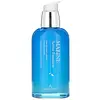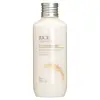What's inside
What's inside
 Key Ingredients
Key Ingredients

 Benefits
Benefits

 Concerns
Concerns

 Ingredients Side-by-side
Ingredients Side-by-side

Water
Skin ConditioningButylene Glycol
HumectantGlycerin
Humectant1,2-Hexanediol
Skin ConditioningBetaine
HumectantAloe Barbadensis Leaf Extract
EmollientPaeonia Lactiflora Bark/Sap Extract
Skin ConditioningLilium Tigrinum Extract
Skin ConditioningNelumbium Speciosum Flower Extract
Skin ConditioningLonicera Japonica Flower Extract
Skin ConditioningChrysanthemum Indicum Flower Extract
Skin ConditioningCucurbita Pepo Fruit Extract
Skin ConditioningSolanum Lycopersicum Fruit Extract
AntioxidantSodium Hyaluronate
HumectantOrbignya Oleifera Seed Oil
EmollientCaprylic/Capric Triglyceride
MaskingHydrogenated Lecithin
EmulsifyingCeramide NP
Skin ConditioningSea Water
HumectantHoney
HumectantPearl Extract
AntioxidantArginine
MaskingPanthenol
Skin ConditioningGlycereth-26
HumectantCarbomer
Emulsion StabilisingSimmondsia Chinensis Seed Oil
EmollientLimnanthes Alba Seed Oil
Skin ConditioningSorbitan Isostearate
EmulsifyingButyrospermum Parkii Butter
Skin ConditioningIsononyl Isononanoate
EmollientPolysorbate 60
EmulsifyingNiacinamide
SmoothingRosa Canina Fruit Oil
EmollientOlea Europaea Fruit Oil
MaskingMacadamia Integrifolia Seed Oil
Skin ConditioningDimethicone
EmollientMyrciaria Dubia Fruit Extract
Skin ConditioningEuterpe Oleracea Fruit Extract
Panax Ginseng Root Extract
EmollientCamellia Sinensis Leaf Extract
AntimicrobialRosa Multiflora Fruit Extract
MaskingGardenia Florida Fruit Extract
Skin ConditioningScutellaria Baicalensis Root Extract
AstringentLigustrum Japonicum Fruit Extract
Skin ConditioningEcklonia Cava Extract
Skin ConditioningHizikia Fusiforme Extract
Skin ConditioningCodium Tomentosum Extract
Skin ProtectingGelidium Cartilagineum Extract
Skin ProtectingAdenosine
Skin ConditioningDisodium EDTA
Leontopodium Alpinum Extract
Skin ConditioningMalva Sylvestris Flower Extract
Skin ConditioningHydrolyzed Collagen
EmollientCamellia Sinensis Callus Culture Extract
PerfumingBambusa Vulgaris Callus Culture Extract
Skin ConditioningEthylhexylglycerin
Skin ConditioningParfum
MaskingWater, Butylene Glycol, Glycerin, 1,2-Hexanediol, Betaine, Aloe Barbadensis Leaf Extract, Paeonia Lactiflora Bark/Sap Extract, Lilium Tigrinum Extract, Nelumbium Speciosum Flower Extract, Lonicera Japonica Flower Extract, Chrysanthemum Indicum Flower Extract, Cucurbita Pepo Fruit Extract, Solanum Lycopersicum Fruit Extract, Sodium Hyaluronate, Orbignya Oleifera Seed Oil, Caprylic/Capric Triglyceride, Hydrogenated Lecithin, Ceramide NP, Sea Water, Honey, Pearl Extract, Arginine, Panthenol, Glycereth-26, Carbomer, Simmondsia Chinensis Seed Oil, Limnanthes Alba Seed Oil, Sorbitan Isostearate, Butyrospermum Parkii Butter, Isononyl Isononanoate, Polysorbate 60, Niacinamide, Rosa Canina Fruit Oil, Olea Europaea Fruit Oil, Macadamia Integrifolia Seed Oil, Dimethicone, Myrciaria Dubia Fruit Extract, Euterpe Oleracea Fruit Extract, Panax Ginseng Root Extract, Camellia Sinensis Leaf Extract, Rosa Multiflora Fruit Extract, Gardenia Florida Fruit Extract, Scutellaria Baicalensis Root Extract, Ligustrum Japonicum Fruit Extract, Ecklonia Cava Extract, Hizikia Fusiforme Extract, Codium Tomentosum Extract, Gelidium Cartilagineum Extract, Adenosine, Disodium EDTA, Leontopodium Alpinum Extract, Malva Sylvestris Flower Extract, Hydrolyzed Collagen, Camellia Sinensis Callus Culture Extract, Bambusa Vulgaris Callus Culture Extract, Ethylhexylglycerin, Parfum
Water
Skin ConditioningGlycerin
HumectantDipropylene Glycol
HumectantCaprylic/Capric Triglyceride
MaskingHydrogenated Polydecene
EmollientBetaine
HumectantPolyglyceryl-3 Methylglucose Distearate
EmulsifyingCyclopentasiloxane
EmollientPanthenol
Skin ConditioningOryza Sativa Extract
AbsorbentDi-C12-13 Alkyl Malate
EmollientCetyl Ethylhexanoate
EmollientCetearyl Alcohol
EmollientButyrospermum Parkii Butter
Skin Conditioning1,2-Hexanediol
Skin ConditioningOryza Sativa Bran Oil
EmollientCeramide NP
Skin ConditioningGlycosphingolipids
EmollientCyclohexasiloxane
EmollientPEG-100 Stearate
Glyceryl Stearate
EmollientCaprylic/Capric Glycerides
EmollientDimethicone
EmollientPhenoxyethanol
PreservativeLecithin
EmollientDimethicone/Vinyl Dimethicone Crosspolymer
Skin ConditioningAcrylates/C10-30 Alkyl Acrylate Crosspolymer
Emulsion StabilisingEthylhexylglycerin
Skin ConditioningPotassium Hydroxide
BufferingCarbomer
Emulsion StabilisingTrisodium EDTA
Sodium Hyaluronate
HumectantIsoceteth-25
EmulsifyingIsoceteth-10
EmulsifyingPolyglyceryl-10 Oleate
Skin ConditioningParfum
MaskingWater, Glycerin, Dipropylene Glycol, Caprylic/Capric Triglyceride, Hydrogenated Polydecene, Betaine, Polyglyceryl-3 Methylglucose Distearate, Cyclopentasiloxane, Panthenol, Oryza Sativa Extract, Di-C12-13 Alkyl Malate, Cetyl Ethylhexanoate, Cetearyl Alcohol, Butyrospermum Parkii Butter, 1,2-Hexanediol, Oryza Sativa Bran Oil, Ceramide NP, Glycosphingolipids, Cyclohexasiloxane, PEG-100 Stearate, Glyceryl Stearate, Caprylic/Capric Glycerides, Dimethicone, Phenoxyethanol, Lecithin, Dimethicone/Vinyl Dimethicone Crosspolymer, Acrylates/C10-30 Alkyl Acrylate Crosspolymer, Ethylhexylglycerin, Potassium Hydroxide, Carbomer, Trisodium EDTA, Sodium Hyaluronate, Isoceteth-25, Isoceteth-10, Polyglyceryl-10 Oleate, Parfum
 Reviews
Reviews

Ingredients Explained
These ingredients are found in both products.
Ingredients higher up in an ingredient list are typically present in a larger amount.
1,2-Hexanediol is a synthetic liquid and another multi-functional powerhouse.
It is a:
- Humectant, drawing moisture into the skin
- Emollient, helping to soften skin
- Solvent, dispersing and stabilizing formulas
- Preservative booster, enhancing the antimicrobial activity of other preservatives
Betaine is a common humectant (a substance that promotes retention of moisture). It's known to be gentle on the skin and can help balance hydration.
This ingredient is best for improving hydration and soothing irritated skin. Studies also show it helps even out skin tone.
Fun fact: Betaine is naturally created in the skin and body. The kind found within cosmetic products can be either plant-derived or synthetic.
Another name for betaine is trimethylglycine.
Learn more about BetaineThis ingredient is also known as shea butter. It is an effective skin hydrator and emollient.
Emollients help soothe and soften your skin. It does this by creating a protective film on your skin. This barrier helps trap moisture and keeps your skin hydrated. Emollients may be effective at treating dry or itchy skin.
Shea butter is rich in antioxidants. Antioxidants help fight free-radicals, or molecules that may harm the body. It is also full of fatty acids including stearic acid and linoleic acid. These acids help replenish the skin and keep skin moisturized.
While Shea Butter has an SPF rating of about 3-4, it is not a sunscreen replacement.
Shea butter may not be fungal acne safe. We recommend speaking with a professional if you have any concerns.
Learn more about Butyrospermum Parkii ButterThis ingredient is an emollient, solvent, and texture enhancer. It is considered a skin-softener by helping the skin prevent moisture loss.
It helps thicken a product's formula and makes it easier to spread by dissolving clumping compounds.
Caprylic Triglyceride is made by combining glycerin with coconut oil, forming a clear liquid.
While there is an assumption Caprylic Triglyceride can clog pores due to it being derived from coconut oil, there is no research supporting this.
Learn more about Caprylic/Capric TriglycerideCarbomer is a polymer of acrylic acid. Its main role is to create a gel consistency.
A high amount of carbomer can cause pilling or balling up of products. Don't worry, most products contain 1% or less of carbomer.
Ceramide NP is a type of ceramide and formally known as ceramide 3.
Ceramides are intercellular lipids naturally found in our skin that bonds dead skin cells together to create a barrier. They are known for their ability to hold water and thus are a great ingredient for dry skin.
Ceramides are an important building block for our skin barrier. A stronger barrier helps the skin look more firm and hydrated. By bolstering the skin ceramides act as a barrier against irritating ingredients. This can help with inflammation as well.
If you would like to eat ceramides, sweet potatoes contain a small amount.
Read more about other common types of ceramides here:
Ceramide AP
Ceramide EOP
Dimethicone is a type of synthetic silicone created from natural materials such as quartz.
What it does:
Dimethicone comes in different viscosities:
Depending on the viscosity, dimethicone has different properties.
Ingredients lists don't always show which type is used, so we recommend reaching out to the brand if you have questions about the viscosity.
This ingredient is unlikely to cause irritation because it does not get absorbed into skin. However, people with silicone allergies should be careful about using this ingredient.
Note: Dimethicone may contribute to pilling. This is because it is not oil or water soluble, so pilling may occur when layered with products. When mixed with heavy oils in a formula, the outcome is also quite greasy.
Learn more about DimethiconeEthylhexylglycerin (we can't pronounce this either) is commonly used as a preservative and skin softener. It is derived from glyceryl.
You might see Ethylhexylglycerin often paired with other preservatives such as phenoxyethanol. Ethylhexylglycerin has been found to increase the effectiveness of these other preservatives.
Glycerin is already naturally found in your skin. It helps moisturize and protect your skin.
A study from 2016 found glycerin to be more effective as a humectant than AHAs and hyaluronic acid.
As a humectant, it helps the skin stay hydrated by pulling moisture to your skin. The low molecular weight of glycerin allows it to pull moisture into the deeper layers of your skin.
Hydrated skin improves your skin barrier; Your skin barrier helps protect against irritants and bacteria.
Glycerin has also been found to have antimicrobial and antiviral properties. Due to these properties, glycerin is often used in wound and burn treatments.
In cosmetics, glycerin is usually derived from plants such as soybean or palm. However, it can also be sourced from animals, such as tallow or animal fat.
This ingredient is organic, colorless, odorless, and non-toxic.
Glycerin is the name for this ingredient in American English. British English uses Glycerol/Glycerine.
Learn more about GlycerinPanthenol is a common ingredient that helps hydrate and soothe the skin. It is found naturally in our skin and hair.
There are two forms of panthenol: D and L.
D-panthenol is also known as dexpanthenol. Most cosmetics use dexpanthenol or a mixture of D and L-panthenol.
Panthenol is famous due to its ability to go deeper into the skin's layers. Using this ingredient has numerous pros (and no cons):
Like hyaluronic acid, panthenol is a humectant. Humectants are able to bind and hold large amounts of water to keep skin hydrated.
This ingredient works well for wound healing. It works by increasing tissue in the wound and helps close open wounds.
Once oxidized, panthenol converts to pantothenic acid. Panthothenic acid is found in all living cells.
This ingredient is also referred to as pro-vitamin B5.
Learn more about PanthenolParfum is a catch-all term for an ingredient or more that is used to give a scent to products.
Also called "fragrance", this ingredient can be a blend of hundreds of chemicals or plant oils. This means every product with "fragrance" or "parfum" in the ingredients list is a different mixture.
For instance, Habanolide is a proprietary trade name for a specific aroma chemical. When used as a fragrance ingredient in cosmetics, most aroma chemicals fall under the broad labeling category of “FRAGRANCE” or “PARFUM” according to EU and US regulations.
The term 'parfum' or 'fragrance' is not regulated in many countries. In many cases, it is up to the brand to define this term.
For instance, many brands choose to label themselves as "fragrance-free" because they are not using synthetic fragrances. However, their products may still contain ingredients such as essential oils that are considered a fragrance by INCI standards.
One example is Calendula flower extract. Calendula is an essential oil that still imparts a scent or 'fragrance'.
Depending on the blend, the ingredients in the mixture can cause allergies and sensitivities on the skin. Some ingredients that are known EU allergens include linalool and citronellol.
Parfum can also be used to mask or cover an unpleasant scent.
The bottom line is: not all fragrances/parfum/ingredients are created equally. If you are worried about fragrances, we recommend taking a closer look at an ingredient. And of course, we always recommend speaking with a professional.
Learn more about ParfumSodium Hyaluronate is hyaluronic acid's salt form. It is commonly derived from the sodium salt of hyaluronic acid.
Like hyaluronic acid, it is great at holding water and acts as a humectant. This makes it a great skin hydrating ingredient.
Sodium Hyaluronate is naturally occurring in our bodies and is mostly found in eye fluid and joints.
These are some other common types of Hyaluronic Acid:
Learn more about Sodium HyaluronateWater. It's the most common cosmetic ingredient of all. You'll usually see it at the top of ingredient lists, meaning that it makes up the largest part of the product.
So why is it so popular? Water most often acts as a solvent - this means that it helps dissolve other ingredients into the formulation.
You'll also recognize water as that liquid we all need to stay alive. If you see this, drink a glass of water. Stay hydrated!
Learn more about Water